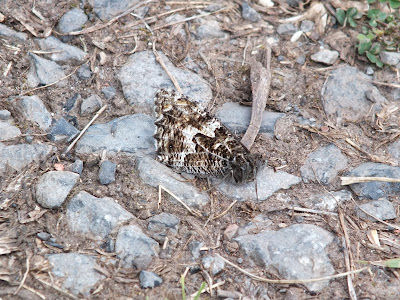Guided Walk......
Today was another scheduled walk, with todays theme being Wildflowers, of course as usual the walk become a general look at the wonderful flora and fauna that is Pembrey Burrows & Saltings LNR.
In warm sunshine with a light WSW breeze we set off to discover the best that was on offer, clearly we thought the host of Pyramidal Orchids would steal the show but when the Butterflies appeared with Marbled White, Dark Green Fritillary, Meadow Brown, and Small Heath providing the mainstay we felt we were on to a great walk.
 |
| Dark Green Fritillary, the best shot I could get!! |
The dragonflies did not disappoint with Emperor, Black-tailed Skimmer, Broad Bodied Chaser, and Common Bluet in good numbers. As usual getting decent photos proved a challenge.
After checking our second refugia of the morning we found one Slow Worm, always a treat.
A walk out towards the beach brought a confusing Orchid, either Early or Southern Marsh? I'll confirm later.
 |
| Early? or Southern Marsh Orchid |
On the look our for oddities brought us into the territory of what must be the luckiest Skylark alive, this leucistic bird has been on site since Novemebr 2015 avoiding the winter resident Merlins.
 |
| Dodgy cropped shot of the leucistic Skylark, (carrying food) |
A nice find was the caterpillar of the Emperor Moth, the moth itself is pretty exciting but the caterpillar is a stunning lime green colour and quite big.
 |
| Emperor Moth caterpillar |
On our final leg back to the car park we came across the best sight of the walk, two then three European Hares a normally secretive mammal, on the reserve, following years of persecution by poachers, but it looked like at least one of the individuals was a Leveret, one of this seasons young... brilliant but don't tell anyone....
 |
| European hare |
On the home front I was having a cup of tea in the garden when I turned to admire the flower border, out of the corner of my eye I saw this fella trundling across the lawn, sadly, given the fact it was four in the afternoon and it didn't seem to bothered by me, I think it is probably a little unwell, although it did tuck into a few juicy Lob worms I dug up for it. Lets hope it ok as it seem to have trundled on out of the garden but I don't know how??
 |
| European Hedgehog |

























